Text
Signing Off, 2018-2021.
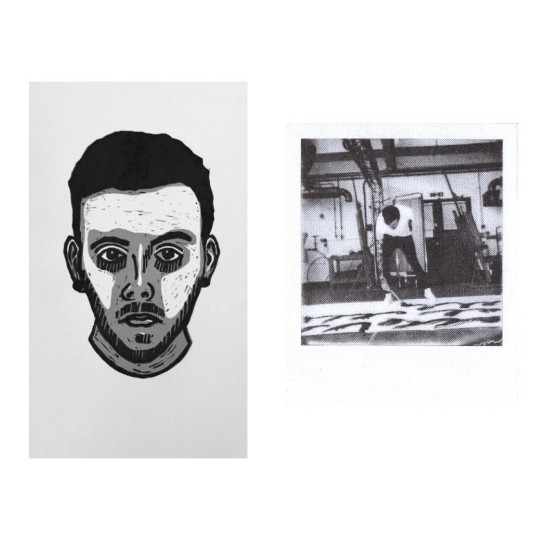
Two very different self-portraits. The first print I made on the Multi-Disciplinary Printmaking Masters Degree next to one of the last - linocut relief print on paper and offset lithography on paper.
When I started the Masters degree three years ago we were told in our introductory talk that we would be required to write a critical journal that would run alongside our creative practice. The journal would be a space where we could further discuss the processes we learn, any artists that inspire us or exhibitions that we visit, as well as explaining how our own practice would progress.
I was not a very confident writer at all, and looking back at the first posts that I wrote evokes the same feeling as looking at old photographs. Nevertheless it was a necessary component of the work we would submit and so I began to think about how I might document and present this body of work. I thought that writing down a summary of every train of thought, every project I start and every module that I complete would be a lot of work for it to merely sit in a ring binder file for only the course leaders to read, and so I made a blog instead.
This blog has become a project in itself, and I have so enjoyed every aspect of it - from designing the theme, to making relevant links in the menu headings, from curating the images of my work to stumbling across new works on the platform’s dashboard. I have been able to keep up this practice during my breaks at work and fleeting moments when travelling on the bus through the city, saving drafts of endless notes to expand upon further when I get a lengthier stretch of time.
The most valuable outcome from this particular blogging journey has been the feedback and kind words from my readers, the numbers of which have slowly crept up over the years. The first post that I wrote about discovering asemic writing is now sitting at 607 notes, which I still cannot get my head around. Though these are mostly comprised of likes and reblogs, these are not to be dismissed, they highlight the level of intrigue that this method of writing has on its viewers. This response has been overwhelmingly encouraging, and I am honestly so grateful to every reader, every like, every reblog and every message that I have received.
Before this course began I never would have seen myself as a blogger, but the more I wrote, the more comfortable I felt with sharing my practice with you all. I am going to continue blogging, as researching and writing have become very important aspects of my practice. However, I am a very organised and particular person, and as such I do not want to potentially confuse or clutter this blog space with future works and thoughts. I would like to keep this as a record of my journey as a masters student, a digital moment in time.
If any of you would like to be kept up to date with how my practice progresses beyond the Masters degree I will be writing frequent blog posts on my website - www.benjenner.co.uk.
All that is left to do at this stage is to express my deepest gratitude again for reading and following my musings up until this point. I hope you continue to do so, as I have a lot of exciting ideas in the pipeline.
Thank you,
Ben.
5 notes
·
View notes
Text
Extended Practice Summary
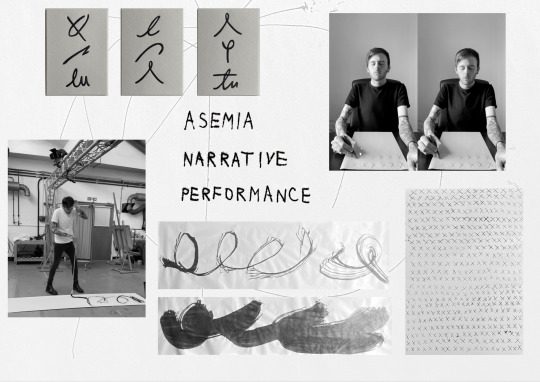
Presentation poster that summarises my practice in three words - digital rendering of mixed media works.
Throughout the last three years as a Multi-Disciplinary Printmaking Masters student my work has endured a development beyond that which I could have ever anticipated. I began the course very unsure of myself and felt incredibly out of my depth, suffering from imposter syndrome and a feeling a general uncertainty that I was a right fit for the course. I have since undertaken a series of modules that have; taught me the basic principles of printmaking, shown me how to understand research as a practice in itself, allowed me to develop ideas in a supportive environment, encouraged me to consider where I would place myself as a creative in a professional context, and ultimately, to produce a body of work that consolidates all of the above. My work has developed quite substantially in this time, beginning with figurative printmaking and ending at the complete opposite end of the spectrum in abstraction. However the concepts at the heart of the work have always remained constant. I have always strived to depict an autobiographical narrative, but the aesthetic, the depth of thought and research have progressed.
At the beginning of the academic year I had surmised that visual poetry and asemic writing were a means by which I could communicate a personal narrative. I had spent the previous year touching upon the theory of asemic writing, and using the skills I had learnt in the printmaking studios to develop ideas and explore this newfound and exciting visual language. Because I had established an area of interest and a research methodology, I sought to utilise this final year to try to locate my audience. I achieved a mindset of discerning that the end of the masters degree is not an ending as such, but the beginning of my career as a creative practitioner that is using the end of the masters degree to segue in to a professional context.
In terms of putting my aims in to practice, I submitted works to a multitude of opportunities, open calls and exhibitions with the intention of placing myself in a professional context and locating my audience simultaneously. As time progressed I understood that I am a representative of more than just one community of artists. I am a Masters degree student, a queer artist, a conceptual artist, a performance artist, a book artist, a visual poet and also a researcher. Therefore, by not defining myself as a fixed identity I was able to explore more avenues and test more places where I might place my work. I submitted works to assembling publications and exhibitions, both digital and physical. The networking that I have carried out as a result of this determination has led to further opportunities, such as exhibiting at Bristol Pride and reaching out to artists whose work touches upon asemic writing in their practice.
I have finally developed my website as a space to host a digital portfolio. A lot of open calls and opportunities ask for an online presence, and I feel a website is considerably more professional than pointing people in the direction of your Instagram profile. I initially made my website to serve as an exhibition space for the Practice in a Professional Context module and for the Bower Ashton Library artist-in-residence exhibition. I am glad to be able to use this space as a permanent display for my work, rather than the awkward digital exhibition venue that it has been - though these were necessary at the time to adhere to government restrictions and social distancing measures.
I have regrettably not become as proactive as I would have liked at engaging with social media. I have grasped that it is a useful means through which ideas can be shared, but I still feel an awkward disconnect with the concept. Perhaps this is because the algorithms mean that there is no definite strategy to employ to get people to actually see your posts. I would rather put more emphasis on encouraging my audience to physically engage with my practice. I have achieved this by collating the work that I would have exhibited at the end of degree exhibition in to an edition of 150 publications that I will share with as many people as possible. I will post this portable exhibition to those that supported me in fundraising for the project, those that I would have invited to the exhibition at university, and I intend to submit the publications that are left over to various libraries and artist’s book archives.
Inevitably the current global crisis affected my practice quite dramatically. Access to university facilities has been sporadic throughout the last year, and this lack of consistency meant that my creative outputs have been staggered as a result. The weeks of isolation and multiple lockdowns hindered motivation and consequently, creative development. This feeling of disconnect that I had with my practice led to a period of reflection. I realised that not having access to the facilities meant that I did not feel the pressure to adhere to printmaking traditions, and that I could explore the more conceptual side of my work from home. This deeper understanding that I had gained of where I want to push my practice led to a much broader body of research, and I found that the gesture and performance of writing was as exciting to me as the works on paper themselves. Both research and performance have peaked my intrigue in the last six months and are areas that I would hope to explore further as my practice progresses after the course has ended.
The coronavirus outbreak affected more than just my university studies, it was also quite damaging to my mental wellbeing. Consequently I have utilised my practice as a coping mechanism throughout the latest lockdown. I have used it as a means of documenting everything that I have felt and experienced in the last year, this includes working in the hospitality industry throughout the whole ordeal, and in particular my feelings towards the treatment of hospitality workers. My third year work has told the story of the pandemic and three lockdowns from my point of view. The various periods of isolation and the loneliness that ensued had a negative impact on my mental health, and so I adapted these feelings into a series of breathing and drawing exercises that became daily rituals that formed a big part of my routine in lockdown.
The repercussions of the current situation meant that I faced many obstacles that required a degree of problem solving. The most notable instance was my time as artist-in-residence at Bower Ashton Library. I developed a body of work from found poetry that I was initially unable to complete due to the nation being locked down. I took to social media to ask my followers to send a found word, from which I could make a lockdown poem and print to send to everyone that had submitted a word. This was a wholesome project that kept my mind occupied in a time of uncertainty, and also a gift for everyone that took part. Upon my return to university I was able to complete the found poetry artist’s book, but the nation went in to a second lockdown just as I was about to exhibit the work. This challenged me to digitise the book that I had made and attribute a QR code to it that I plastered all around the city. My aim was for a new audience of passers-by to find my exhibition by chance, continuing the ethos of found poetry in a whole new context. I also spent the remaining budget from the residency on making the book into lo-fi zines that I could also distribute, wanting as many people to physically interact with the book as possible. I was particularly proud of this project, it showed that a little determination could enable me to see my ideas realise themselves in surprising and creative ways.
I have proven to myself that I can fulfil everything that I had proposed at the start of the year with very little in the way of facilities and materials. The majority of my final year’s worth of work was conducted from my bedroom with a roller and some etching ink. This low maintenance method of working is completely transferrable to anywhere in the world, which really is an exciting discovery to make so early on in my career as an artist. Armed with the knowledge that I do not necessarily need studios to develop ideas, I had the confidence to propose a project to an artist residency in rural Italy. I will be placing myself in the community and examining through first hand research how ideas of asemic writing and narrative might translate in a setting where the language spoken is not my mother tongue. I am intrigued as to the otherness of language, and how a language that I do not understand might be transcribed visually. The proposal itself is also transferrable, and has the potential to be explored on a global scale.
There is much scope for further research within asemic writing, and handwriting as a whole. I have enjoyed having the masters degree as a part time constant, but the nature of this part time study has meant that I have not been able to dedicate as much time to my practice as I would have liked. Asemic writing is an under researched area of study, and it deserves more time and commitment than I have been able to afford in the last few years. With this in mind I intend to write a proposal for PhD research. I am keen to explore ideas of asemic writing, narrative and comprehension, and will utilise everything that I have read and learnt in the last two years in particular as a basis for this proposal.
I cannot commend this course highly enough. Having the support to develop and explore my practice has been truly invaluable. I have seen my work mature in to a coherent practice with a clear path forwards beyond the confines of university. This confidence in my practice would not have been achieved without the continuous backing of the module leaders, my peer group, and studio culture as a whole. I have found my creative voice, and am excited to use everything that I have learnt as a student on this course to establish a future for myself as an artist.
#practice#summary#evaluation#report#asemic#asemic writing#performance#performance art#printmaking#masters#mamdp
8 notes
·
View notes
Text
Everything that I’ve wanted to say but haven’t had the confidence to until now
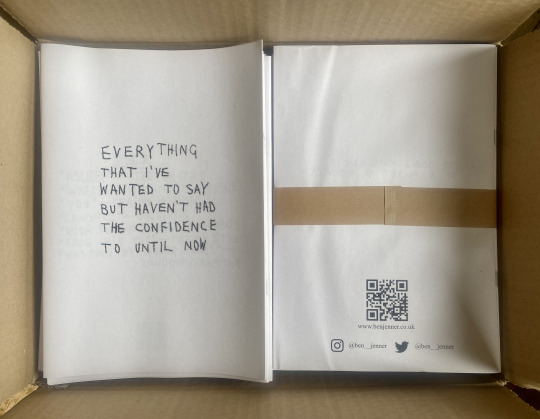
‘Everything that I’ve wanted to say but haven’t had the confidence to until now’ publication.
The ethos of this module has been to discover creative ways in which I can connect with my audience. Since the cancellation of this year’s end of degree show I have been conflicted at the prospect of a digital showcase and have been researching ways in which my work can be received in the physical sense. In a world where we scroll past artwork and give thoughtless ‘likes’ and ‘thumbs ups’, I wanted the reception of my work to be more considered and thoughtful and make my audience slow down for just a moment.
For months I had thought about making a publication at the end of the year that would consolidate my third year work in the form of a newspaper. My interest in the newspaper as an object was peaked by Guy Bigland’s workshop where he explained that the newspaper was a dying medium. I think this resonated because of the research I have carried out with handwriting falling under this same seemingly antiquated umbrella. On reflection, I felt that the newspaper carried with it connotations of either formality and seriousness or gossip and celebrity culture. These associations are difficult for audiences to disassociate with, despite what the actual subject matter of the publication may be, and so I decided to rethink my ideas of how to present this collection of works. I think because this publication is taking the place of an exhibition I had ideas of it needing to be grand and formal, when in essence this would detract from what the work is actually about.
I had samples from The Newspaper Club sent to me in the post which gave further insight in to how my publication might look. One such sample was of a zine, which I began to think might be more appropriate for what it was I was trying to say. The paper quality is of the same standard as a newspaper, so the audience reception would be similar to how they might approach this traditional form of relaying information. However the size is smaller, and as a result is much more intimate.
The works found in the publication are a personal account of the pandemic. This includes the relentless lockdowns and periods of isolation, the loneliness that ensued as a result of these, the dire predicament of working in the hospitality industry throughout the whole ordeal and my feelings towards this, and finally the rare moments of quiet in between the anxiety, and how my creative practice has been a constant crux right from the beginning of the pandemic.
I feel that experiencing this work in a tangible way is paramount to reading the emotive content it offers. Contemporary society is oversaturated with digital media across a great many platforms and I did not want my story to get lost in a split second of someone’s screen time. Social media and virtual showcases will be used to share the work but these will only communicate so far. The publication will undoubtedly exist on multiple platforms, but I would like it to predominantly be experienced in the physical.
‘Everything that I’ve wanted to say but haven’t had the confidence to until now’ is how I described this collection of drawings, prints, poetry and performances in a presentation that I gave earlier in the year. I noted it down as I really felt that it rung true to where I currently stood, not only as an artist but within myself as well.

‘Everything that I’ve wanted to say but haven’t had the confidence to until now’ publication front cover - monoprint on paper.
The format of the zine itself communicates various aspects of my practice. It is divided in to two sections, Side A and Side B, a reference to cassette tapes. Dividing the publication in to chapters alludes to the sense of narrative that is present in all aspects of work. Side A addresses the negative moments of the pandemic and Side B has a much lighter tone. At the beginning of each section is a playlist, a reference to the layout of my sketchbooks. At the beginning of each sketchbook I begin a playlist that is personal to that book. When I reflect on past sketchbooks I know how I was feeling and what I was thinking by looking through the playlist. Side A is comprised of songs that I listened to when I was feeling down, and Side B was during the times I felt more optimistic and motivated. I have also made a QR code for each playlist so that the reader can further interact with the zine and listen to what I was listening to when when making the works that they are flicking through. QR codes are also very topical at the moment as they have become a part of our every day life, from checking in to locations with the NHS Test and Trace app to reading and ordering from a menu at a pub or restaurant. The inclusion of the QR code adds another dimension to the publication that combines traditional ideas with contemporary purposes.

‘Side A’ playlist - monoprint on paper.
The zine contains a narrative of asemic works that respond to the current global crisis, some of these responses address the days where I struggled within myself and became outward reflections of inner feelings, and some respond to the hierarchical dynamic that became apparent in the hospitality industry. A few of the asemic works have been paired with poems that I have written in the last year. I chose to appropriate these as monoprints, a nod to the work I made before I rejoined the course (and have continued to explore throughout), a further reminder of how far I have come and how much work has progressed.
Side B offers works from my performative explorations, where I began to utilise my practice to cope with and overcome my lockdown struggles. The first of which is from the ‘Exhale’ performances and the second from the ‘Letter of Resignation’ performances. I wanted to include screenshots from the videos so there was a feeling of animation and movement as the reader journeys though the pages, but did not want the appearance of these to distract from the aesthetic of the publication. Therefore I printed these on the offset lithography press. The finished prints almost look like mid-20th Century American high school year book portraits - adding to the traditional tone I was hoping to achieve.

Screenshot from the ‘Exhale’ drawing performance - offset lithography on paper.
I understood that in order for the publication to be assessed and meet the criteria for the newly adopted blended learning approach to teaching that I would have to decide upon a method of digitising the zine somehow. I thought that scanning in each individual page or submitting it as a .pdf document would completely undermine what I was intending to achieve, and so I collaborated with filmmakers, Tom Crane and Lianna Denwood who documented the zine in their own creative voice. I gave Tom and Lianna a copy of the zine and allowed them to produce a short narrative that highlights the quiet tone of the book. They included fragments of songs from the playlists that give prominence to how the audience might engage with the QR code playlists, in effect the soundtrack is both narrational and instructional.
undefined
youtube
I am incredibly proud of this piece of work. It is my largest edition to date, sitting at 150 copies. I intend to circulate these amongst my audience as invitations to a moment of reflection and poignant human think time, away from internet instantaneity. I am unsure as to the reception that the publication will meet, but it would be my hope there are moments in the pages that encourage the reader to consider and muse on.
#practice#publication#zine#narrative#lithography#asemic#asemic art#asemic writing#poetry#visual poetry#vispo#qr#cassette#performance#performance art#printmaking#masters#mamdp
9 notes
·
View notes
Text
Fantasy Exhibition

‘Inchkeith 2221 exhibition mock-up’ - digital concept art by Damián Portela.
Inchkeith 2221
‘As the alphabet is surpassed, thought will liberate itself from speech, and other, nonlinguistic thought (mathematical and pictorial, and presumably new ones as well) will expand in ways we cannot yet anticipate.’ (Flusser 63)
The coronavirus outbreak of 2020 was just the tip of the iceberg. After a succession of pandemics and consequent recessions the world began to rethink its methods of making money, and capitalism soared to dizzying heights. People were urged to place less emphasis on recreational activities in favour of using their time productively. This concept when coupled with new technologies meant that handwriting became obsolete. The human race became so dependant on everything being immediate that it was decided long ago that to write by hand was a waste of both time and resources, both of which cost money. As a result, all communication in 2221 is conducted by thought and transmitted digitally. Artefacts, artworks, books, manuscripts and documents have been digitised. The information exists, just not in the physical sense. Objects require space, and space can be used more profitably for housing and businesses and suchlike.
My proposal has been accepted to exhibit at the World Record of Inscriptions, Transcriptions and Expressions (W.R.I.T.E.) and aims to re-introduce the reality of the written mark to the people of 2221.
The work that I will present will be divided in to two acts in separate rooms. Act One will be an exhibition of the body of work I have made during my third year of study. This celebration of the performance of asemic writing has been a record of my thoughts and feelings throughout the pandemic, and so is an appropriate subject matter for a future world that has been so shaped by the aftermath of a string of pandemics. I have allowed these works to be digitised so that they are in keeping with what the people of 2221 would expect from an exhibition space in this time.
Act One takes place in a vast open expanse of white walls that exude a clinical coldness. This is typical of the architecture of this era - minimal distractions from the lack of decor and no furnishing meaning that every space is multi-functional and able to maximise profitability. There are a series of podiums on the floor that light up from above, hologram recordings of my performance writings are displayed here. The works on paper are projected away from the edges of the room, in such a way that the audience can walk around them. It is important in 2221 to obtain as much information as quickly as possible, and as such, mounting a work on the wall would leave questions as to what is on the reverse, and having questions means looking for answers, and this requires time, which as we know, time is money.
The handwritten mark is a foreign concept in this era, and so I would hope that the intrigue of my performances and artworks would peak the curiosity of the audience. They will be invited in to a second room where Act Two will take place. Act Two takes its inspiration from the ideas of James IV of Scotland’s language experiment on the island of Inchkeith. He was curious to discover what verbal language two infant children might speak if they grew up isolated from the influence of society. I too am curious to learn what the handwritten language of the population of 2221 might look like considering they have not had the opportunity to explore this tactile mode of communication before.
Act Two is also influenced by the handwriting teaching methods of Martin Andersch, and offers a range of physical drawing implements to be interacted with and explored. I propose a collaborative and interactive experience that obscures the distinction between artist and spectator. How might someone even hold a drawing or writing instrument if they have never seen one in the physical sense before? The population are taught from a young age how to recognise letterforms and how to transmit these communications through various advanced technologies, but they are never given a pen to hold. They are not taught how to perform these glyphs on the page as we are today, as this is not deemed an efficient use of time. I should make it clear that these notions are not laws, but are attitudes that have been adopted and developed over time. That is not to say that these works will be welcomed with open arms, they might appear rather primitive against their progressive modes of communication. I would encourage all attendees to approach the activity with an open mind and the works made would be displayed as a tangible record of these receptive happenings.
On my return to 2021 I will document the development of these works into publications that will become not only a concluding creative output, but also a memento of the importance of the gesture of handwriting - expressing our personality and individuality. This exhibition will serve as a reminder to slow down, not race towards unachievable ideas of being productive at every waking moment, not to place so much importance on existing in a digital space, and to enjoy all the benefits that come from being physically present.
#practice#fantasy#writing#creative writing#future#concept art#exhibition#exhibition mock#handwriting#asemic#asemic writing#asemic art#performance#performance art#printmaking#masters#mamdp
1 note
·
View note
Text
Shodo
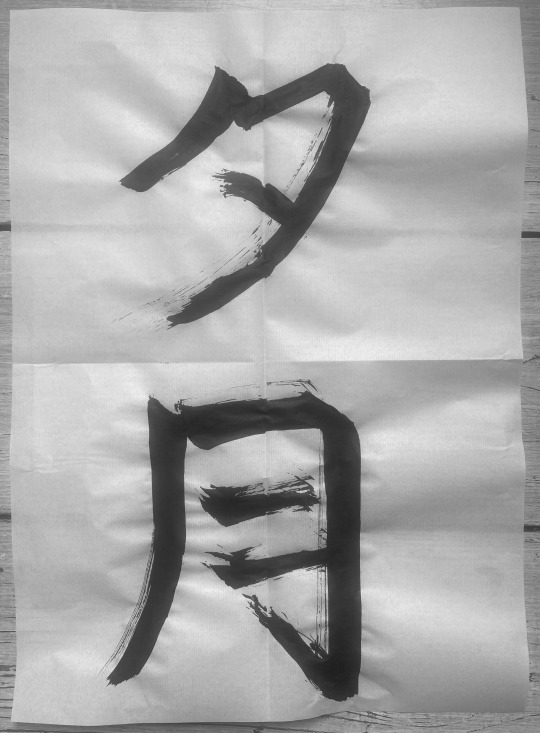
‘Yugetsu’ kanji practice - ink on calligraphy paper (hanshi).
After conducting my research into performance writing I was keen to explore the Japanese art of Shodo. I introduced ideas of ritualistic breathing exercises with drawing to my practice whilst in lockdown, and Shodo seemed like a logical art to explore as it focuses on the union of body and mind.
I undertook an online course that serves as an introduction to the art of Shodo and was taught by master calligrapher, Rie Takeda. The course consisted of a series of pre-recorded videos, online resources, guides for where to source the necessary specialist equipment as well as an online forum for Shodo students to interact and share ideas.
Shodo is one of the oldest and most profound art forms in Japan, its origins have been traced back to the fifth century. We were introduced to several Japanese terms in relation to this art form that I found of particular interest as I do enjoy learning of the origin of words.
The word ‘Shodo’ is composed from the kanji characters ‘sho’ which means to write and ‘do’ which means the path or the Tao. In Eastern philosophy the body and mind are one, they do not exist as separate entities. When both body and mind are united you are closer to a sense of ‘mushin’. ‘Mushin’ is a zen word that consists of two kanji characters; ‘mu’ which means emptiness or nothingness, and ‘shin’; which means heart, mind, feeling, intuition, soul, and spirit. In essence when your body and mind are connected you have a much clearer mind that is free from disturbance and distracting thoughts.
We were then introduced to the different aesthetics of written characters. ‘Kaisho’ is the most common, it is a block style character form that is mostly found in books and printed media. ‘Sosho’ is cursive and is much more difficult to read. It was developed as an abbreviated style for writing quickly, for example taking notes in a lecture. It is mostly found in artworks and most poetry is written in this way. ‘Gyosho’ avoids shapes and angles and does not have a clear straight line, it exists somewhere in-between kaisho and sosho. Kaisho is said to be the best style to learn the foundation of Shodo techniques and basic brush movements.
The materials themselves are an integral aspect of this art form. They are not only utilised for practice but their symbolism is also important. They are known as ‘form treasures of the study’, and the preparation of the materials is the beginning of the meditational process of achieving a state of mushin. The practice begins with the preparing of the ink. A little water is poured on to the ink stone (suzuri) and the ink stick (sumi) is slowly taken in and out of the water. An emphasis was placed on breathing at this stage as we guide the ink stick on its journey to becoming a usable drawing material. As we approached this moment of quiet we begin to notice the water becoming thicker as it becomes a drawing ink. At this stage we were ready to begin mark making.
Takeda provided us with information sheets that advised us through the steps of performing traditional kanji characters. We were being taught to write the kanji for evening moon (yugetsu), and were taken through a series of mark making exercises that taught us how to perform the gestures necessary to write the finished kanji.

Directions for how to perform the gestures for the kanji, ‘yugetsu’.
I found this a very challenging but rewarding series of exercises that made me reflect on my own ideas of achieving a sense of calm in my practice. I had previously thought that connecting with my inner self would be relatively straight forward, but found it difficult at times to achieve a state of tranquility. The frustrating part was that it was very telling in the marks that you make whether this state has been achieved or not.
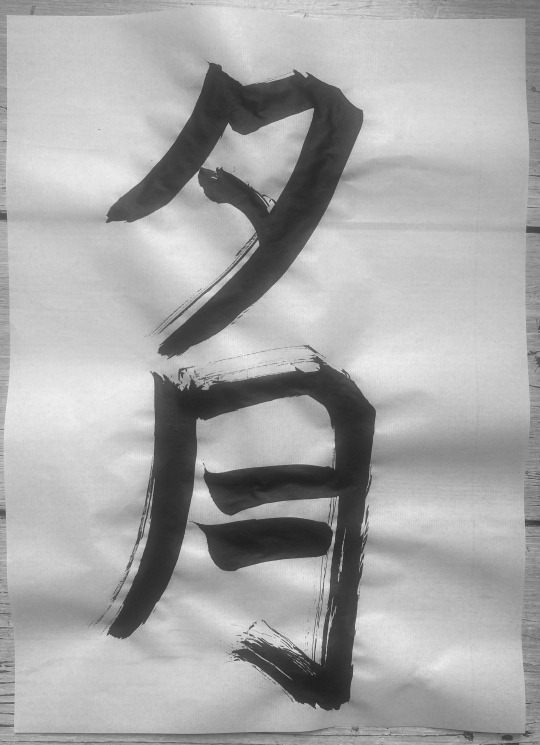
‘Yugetsu’ kanji practice - ink on calligraphy paper (hanshi).
I intend to continue exploring this practice as I have a developed an interest in the last year of calligraphy from other cultures. The otherness of this writing has parallels with asemic writing in that we do not understand its semantic meaning, but recognise its expressive meaning. The difference being we know the semantic meaning exists, we just do not have access to it so enjoy it for its aesthetic and emotive qualities. I would like to approach this area of interest in the hopes that it could deepen my understanding of unfamiliar languages and calligraphies.
I would also like to be mindful of the mushin state of mind in my practice outside of the Shodo tradition. I wonder how achieving mushin would impact the works that I make, in particular, how the performative works would benefit from an introduction of stillness before the writing begins.
#practice#shodo#calligraphy#kanji#japanese#mushin#performance#performance art#performance calligraphy#printmaking#masters#mamdp#processes
2 notes
·
View notes
Text
Performance Writing

‘Letter of Resignation’ - performance writing.
This last year in particular I have started to become more comfortable with the fact that I am as excited by the performative act of making as I am by the consequential drawing or print. I think because my research has led to intense discourse about the disappearance of handwriting, I have become increasingly aware of this being an important aspect of my practice. As such I have started to document the process and creation of some artworks, regarding these performances just as important as than the finished outputs themselves.
These drawings were mostly produced at home, but eventually became tiresome and monotonous. I think because I was limited to the desk in my bedroom, I felt as though everything was whispered and restricted. Once university began to slowly reopen I was able to get hold of a space big enough that I could really spread out, and when not confined by space I was able to shout about how I was feeling rather than whisper. This release was exactly what I needed to breathe a bit of life back into my practice and I am very excited by the results.
The following performances are titled ‘Letters of Resignation’. The title is an homage to the works of the same name by Cy Twombly, an artist that is widely recognised for his works that have quite clear connections to asemic writing. Furthermore there are many suggestions that can be derived from this title; letters in the sense of individual written characters, letters that we write in correspondence, resigning from a job and resigning to the fact that this is just how life is now. I enjoyed the multiple meanings that can be deduced from this, just as there are multiple ways that we can read and understand asemic writing.
youtube
‘Letter of Resignation’ - performance writing.
youtube
‘Letter of Resignation’ - performance writing.
I conducted this series of performances because I wanted to spread out and enjoy not being limited to a domestic space. I unravelled a roll of Fabriano paper and performed a series of asemic written works to music with a mop, a handheld jug mop, and a drawing instrument that I made with bamboo cane and string. These instruments are all evidently larger than a pen or paintbrush, and so in writing with these on the oversized paper I was making myself more aware that this performance was more of a spectacle than writing at my desk with a pen.
I write every single day, therefore I perform every day, and yet I was not consciously aware that the performance was taking place. It is interesting that the change in writing implement made me acutely alert to this fact. This is definitely something to think about in terms of the context of how or where the performance is taking place.
Does a performance need to be documented or witnessed in order to describe it as a performance? If I sit at my desk and write a letter, is it any less performance as it would be to do the exact same thing but go live on social media whilst doing it? Is every act of writing a performance, or is it a performance because it is labelled as such? I have begun to read more about some artists that explore performance in their practice in the hopes of learning more about why this method of communicating my ideas has peaked my interest.
Inoue Yûichi
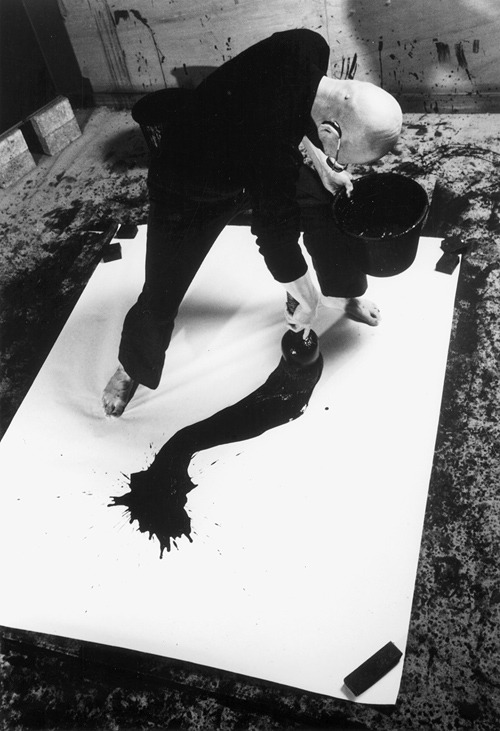
Inoue Yûichi in his studio by Itô Tokio, 1984 - photograph.
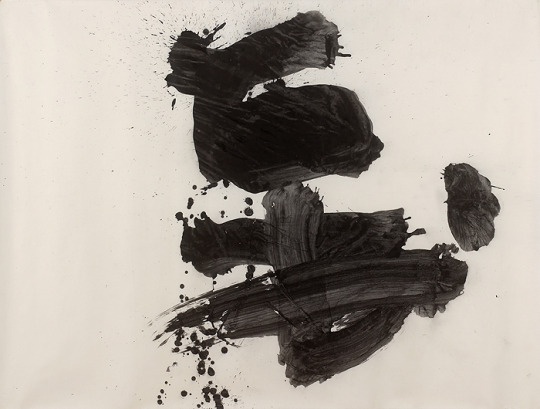
‘Katsu (Sound of Metal)’ by Inoue Yûichi, 1977 - ink on paper.
Inoue Yûichi, was a Japanese artist who began working as a primary school teacher, before retraining under the tutelage of calligrapher, Ueda Sokyu. He came to the practice later on in life but is now regarded as one of the most esteemed Japanese artists of the last century. He co-founded the avant-garde society for calligraphy which in turn saw his push for liberation from calligraphy’s traditional roots, advocating documentation of the calligrapher’s physical movements and energy as being equally as paramount as the textual pieces themselves.
Yûichi depicts traditional Japanese kanji characters, having been predominantly inspired by traditional masters of Japanese calligraphy, but performs them in such a way that has been likened to abstract expressionist action painters. This meeting of Eastern and Western culture culminates in a performative practice that is a pure expression of being in the present moment. He allowed himself to enter a state of calm that is standard practice of the Japanese art of ‘Shodo’, which connects the mind with the body. This calm state of being is thus expressed in his written performance.
Nakajima Hiroyuki
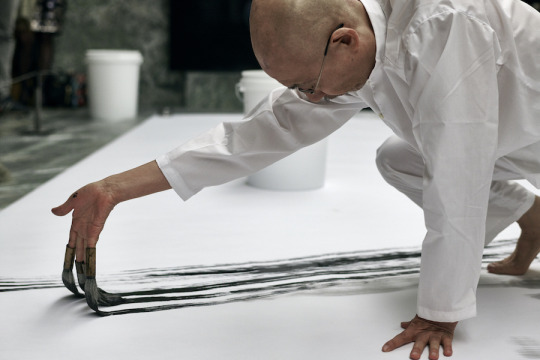
‘Calligraphies Sonores’ by Nakajima Hiroyuki, 2018 - performance at Villa Cavrois Lille in France.
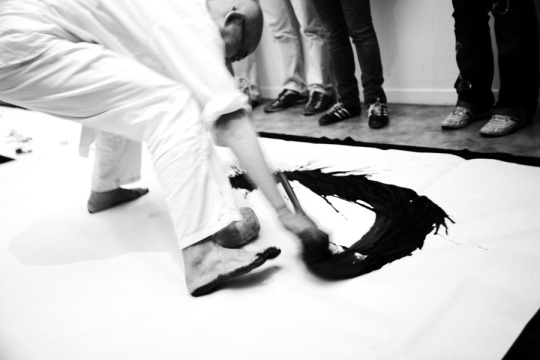
‘Shizen’ by Nakajima Hiroyuki, 2012 - performance at Galeria Nobili Milano in Italy.
Nakajima Hiroyuki is a performance artist, also from Japan, but learnt the art of Shodo from a young age. Hiroyuki understood that the art of calligraphy was highly sought after, but recognised that it had the potential to surpass tradition. He began to create abstract artworks based on his deep knowledge of Japanese calligraphy.
Not long after he began exhibiting his calligraphic abstract forms, he introduced elements of Tai Chi in to his practice, aiming to establish the process of calligraphy by way of performance. He begins his performances by standing in a meditative situation, as per traditional Shodo practices, and then in one swift movement he creates his written thoughts as an evidence of that point in time.
Hiroyuki says:
“Every work of "Sho" is created in one continuous motion, and therefore cannot be repeated or re-written. The power of "Sho" lies in this feature of non-recurrence. Even if you draw the same letter ten times, ten different forms will arise spontaneously.”
I am drawn to the sense of calm and quiet in both Yûichi and Hiroyuki’s performances. The influence of Zen Buddhism and traditional leanings makes for a great basis on which to build from. They utilise traditional ideas in conjunction with contemporary art practice to create performance writings that are not only dynamic but also speak of their cultural backgrounds.
James Nares
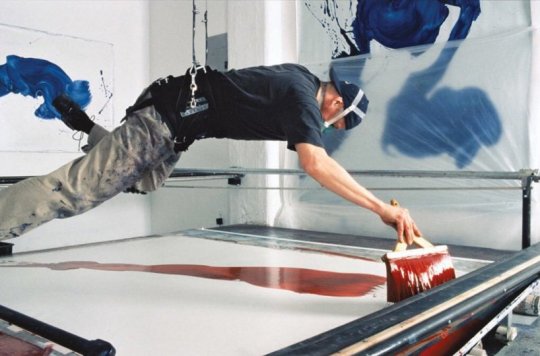
James Nares is a multi-disciplinary artist whose practice includes; film, music, painting, photography and performance. He uses these methodologies to explore ideas of physicality and motion.
In the 1980s Nares began creating what are now his iconic brush stroke calligraphic paintings. These paintings document a gestural and expressive moment, a record of motion across the surface, and are inspired by Roy Lichtenstein’s own depictions of brush strokes.
Nares suspends himself on wires above the canvas in what looks to be a slightly precarious Mission Impossible manner. This inclusion of an outside source in which to aid the creation of the painting further enhances the idea of performance, bringing an element of true action to the forefront of the drawing. The innovative employment of the wires does add an extra dimension to the works, though I would tend to think that they are required for logistic purposes as opposed to it being performance art. Nevertheless it is an interesting way in which to create a drawing, and an added point of interest.

‘Girl About Town’ by James Nares, 2017 - screenprint on paper.

‘Damian’ by James Nares, 2014 - screenprint on paper.
Janine Antoni
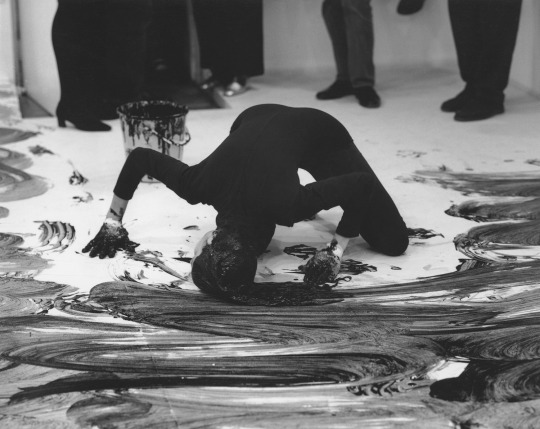
‘Loving Care’ by Janine Antoni, 1993 - performance with hair dye.
Janine Antoni’s work sits in the space between performance and installation. She addresses everyday activities such as eating and bathing and transforms these routines in to art, chiefly using her own body as her method of conveying these ideas.
Antoni has performed pieces where she has scraped away at both lard and chocolate with her teeth, as well as washing away exact replicas of her face made from soap. The piece I am most drawn to is ‘Loving Care’, a performance whereby Antoni mopped the floor with her own hair, soaked in ‘Loving Care’ hair dye. She explains that in doing this she learns and reconnects with her body, finding an understanding with what happens when she puts her body in such an uncompromising space. I am reminded of the body prints by David Hammons and the performative prints that I studied in the Research Practice module. Hammons expressed a sense of cultural identity by using his body as a matrix for printing and mark-making.
Antoni could also be seen to be putting forth a thought-provoking address of antiquated views of femininity in the domestic setting in collusion with action painting. Mopping been seen as a domestic chore and action painting popularised by abstract expressionism which was predominantly populated by men.
This is a great instance of performance drawing, an example of the artist claiming the space as her canvas, and forcing the audience out of the room as she did so. Again, I enjoy the sense of performance art as a means of describing one's identity, this case being an emotional articulation of gender identity.
Franz Erhard Walther

Politisch (Political), no. 36 by Franz Erhard Walther, 1967 - performance.
I came across the work of Franz Erhard Walther during my research of the Fluxus movement. He is a German artist that rose to prominence with his participatory and activated sculptural works.
‘Werksatz’ is a series of roughly fifty wearable sculptures that are activated through audience interaction, and an exploration is made of the demands that they place on the human body. These demands are furthered by the possibility of the relationships that the objects prompt between additional participants. The fabric objects consist of a multitude of openings, fastenings and straps that encourage the user to wear and initiate them, either as a solo performance or as a collective effort.
Walther explains that the motivation behind the wearable sculptures was to understand the negotiation between dormant and active states. This in turn suggests how the materiality of the works might change the body’s behaviour. It is also interesting to note how some of the pieces depended upon the audience’s ability to achieve an awareness of harmony within the structure, making the piece a confrontation as opposed to a simple Happening. I do like this sense of participation from the audience, if it weren't a risk to health and safety this would be something I would have been keen to explore at my end of degree show. Perhaps urging the audience to create their own asemic works in response or alongside my own. This is still food for thought for further study, as restrictions begin to ease.

Körpergewichte (Body Weights), no. 48 by Franz Erhard Walther, 1969 (performed in 2008) - performance.
Nancy Murphy Spicer
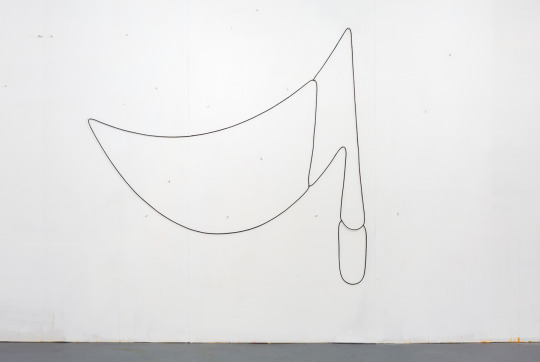
‘Hanging Drawings, 20 successive drawings, unique and unrehearsed’ by Nancy Murphy Spicer, 2015 - installation and performance.
I met Nancy Murphy Spicer as an undergraduate student after she gave a talk to my year group about her drawing practice. I have since read that she created a participatory drawing performance that questions the very nature of drawing. She establishes the line as a sensuous object that can be touched, moved and manipulated. The result is a participatory installation that invites the audience forth to engage with the line and create their own drawing.
It is an interesting conception of the physicality of drawing. The artist has brought forth the tools in which the drawing is to be made, but ultimately it is the spectator that activates its agency as a drawing. This notion not only melds the roles of artist and audience, but also gallery and art studio.
The hanging drawings also touch upon the idea posited by Hiroyuki about the same drawing never being able to be repeated - ‘even if you draw the same letter ten times, ten different forms will arise spontaneously’. This is a thought that I have come back to multiple times throughout this course, the idea of the multiple and the edition. I am a printmaker that is excited by the accidental and incidental unplanned marks, and so the notion of works that can never be repeated is something that I have explored time and time again through print, drawing, writing, and now performance.
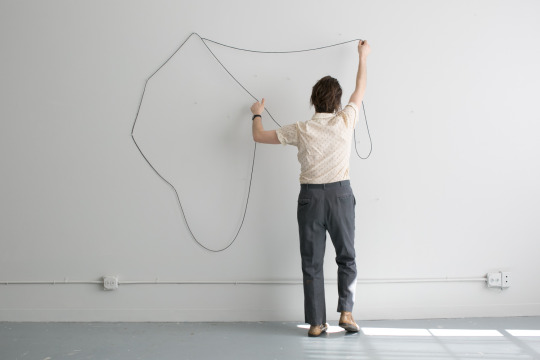
‘Hanging Drawings, 20 successive drawings, unique and unrehearsed’ by Nancy Murphy-Spicer, 2015 - installation and performance.
In researching ideas of performance drawing and performance writing, I again find myself being reminded of the Fluxus movement. I would propose that these performances are both Happenings and event scores. I think that this might be an avenue to explore going forward, the capacity for asemic writing to exist both as performance and event score. I do not see Letters of Resignation as a finished piece, but as a starting point to which I could further investigate. Perhaps I could record more written pieces that are less dramatic and focus more on the every day written works. These are just as much performance even without the great expanse and exaggerated writing implements.
#practice#influences#performance#performance art#performance drawing#performance writing#cy twombly#action painting#abstract art#abstract expressionism#fluxus#happenings#event score#score#asemic#asemic art#asemic writing#printmaking#masters#mamdp#processes
12 notes
·
View notes
Text
Handwriting Continued
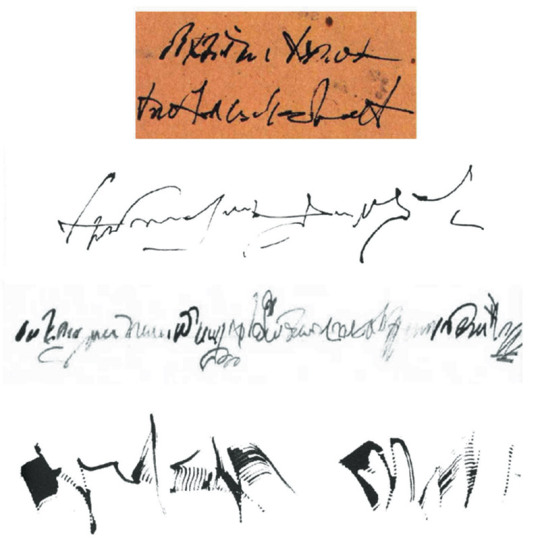
Studies of fantasy writing as found in ‘Symbols Signs Letters’ by Martin Andersch, 1989.
‘These are the two factors that are responsible for the state of the writing art: the decay of education on the subject in our schools and the digitalisation of letters that turns variation into repetition.’ (Andersch, 11)
I have continued reading about handwriting theory and came across a book called ‘Symbols Signs Letters’ by Martin Andersch. The book is described by Andersch as being a picture book as opposed to a text book, and documents the teaching methods that he developed whilst teaching calligraphy and lettering in the 1960s. Being published in the late 1980s it is a little more open-minded in terms of its approach and theory than the ‘Good Handwriting and How to Acquire It’ book, though it is still endearingly dated in terms of some of the expressions used.
Andersch began his teaching by breaking down his students’ previous ideas of the concept of what it is to write by hand. The first lesson he taught was an ‘invitation to fantasy’, whereby he gave his students a series of writing implements such as leaves, ribbons and matches, and allowed them to freely improvise a rhythm on the page. What followed was a series of asemic writing, before the term asemic writing had even been conceived. There was much emphasis on rhythm in this first block of taught sessions. Andersch encouraged the transferral of sensations from the body to the drawing instrument. These rhythmical glyphs were said to awaken sensibilities, allowing the mind to ‘focus on meditation, reflection and self-consciousness’. (Andersch, 14)
Later in this module Andersch prompted his students to enter this meditative state through listening to music, singing and sometimes screaming - which they all happily obliged. There are absolute parallels between these concepts and those that I have been exploring since I first discovered asemic writing, from transcribing music to embodying tranquil, meditative states whilst drawing. He even notes the importance of breathing techniques, stating that both writing and breathing are rhythmical activities. I noticed the importance of this in my own works, particularly the intentional attention I paid to breathing in the ‘Exhale’ prints, compared to the erratic state of mind I was in when making the anxiety-influenced monotypes when lockdown came to an end.
I did enjoy the way Andersch described this first module as a fantasy writing. The inclusion of a variety of unconventional writing instruments made the process lighthearted, and might have encouraged a sense of play and whimsy in his students. The term fantasy conjures notions of daydreams and make-believe, possibly alluding to a conlang (constructed language) of which I have also touched upon briefly in the past.
It is interesting to note that the majority of books that I have been reading about handwriting have been written during the transition from the pre-Digital Age to the Digital Age. I am writing with a wistful view of hindsight whereas both Andwersh and Tarr were living in a time of change where the digital revolution was powering forwards. I am looking back at an age where the handwritten word was commonplace and personality was evident in every word written, whereas they were hesitant and fearful for the future of handwriting. Further discourse from contemporary reading has the same view of looking back with an almost regretful mourning of what was.
I personally believe that we are not past the point of no return, and that handwriting can still be encouraged alongside digital media. There is potential to explore handwriting in a way that is investigative but also experimental. Taking Andwersch’s lead, perhaps an inquiry in to participatory works might spark an enthusiasm for writing by hand. If a series of unorthodox writing utensils and methods were encouraged then it might make the idea less formal and archaic. This is something to consider for future works, either workshops, interactive exhibitions, or even artist residencies.
#practice#influences#handwriting#writing#cursive#asemic#asemic writing#asemic art#printmaking#masters#mamdp
2 notes
·
View notes
Text
Establishing a Peer Group
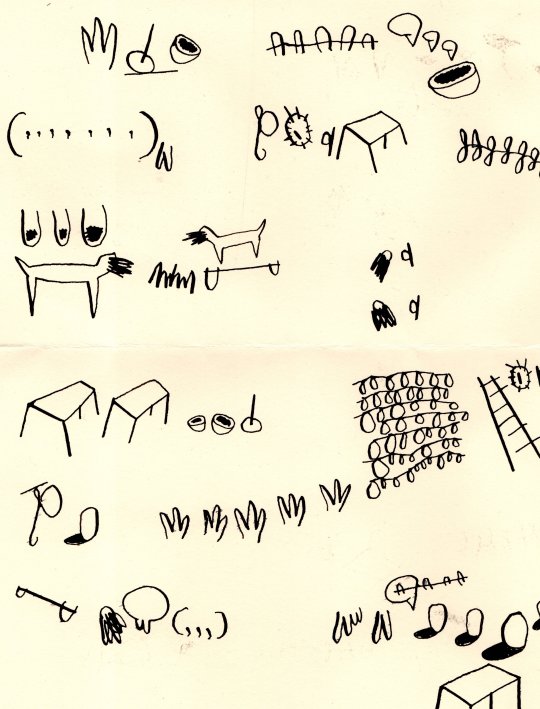
Mail art correspondence with American artist, Steph Parnes - ink on paper.
As I approach the end of the academic year and the masters degree as a whole, I am thinking forward to life away from university and the importance of having a support network in place.
I attended an online lecture at the beginning of the year hosted by British Ceramics Biennial that was about the importance of networking and how it is possible to make networking work for you as a creative practitioner. During the talk by artist and co-director of The Portland Inn Project, Rebecca Davies, it was suggested that sometimes we find the term ‘networking’ itself intimidating because it sounds very corporate. The terminology alludes to white wall galleries and men in suits with business cards, when it ought to be approached as a term that evokes an impression of support and care. The idea of picking yourself up and placing yourself into a group might sometimes not be the most fruitful course of action. It might be just as beneficial to create your own network, and build upon that. This idea made me feel so much less overwhelmed at the prospect of networking and the term itself not as daunting.
I have become very close to some of my peers on the course and though we have vastly different interests and produce a diverse collection of creative outputs, we all bring different codes and life experiences to the table. For this reason the feedback and motivation I garner from the university studio culture is varied and truly invaluable. I am not naive to think that after university we will be in each other’s pockets, but would aim to keep the correspondence going by means of group chats and social media support.
We were also introduced to the idea of a ‘blind crit’ earlier in the year. This was put forth by artist, Emma Gregory, who told us of how her own peer group would leave artworks out on a table for people to peruse and then leave notes of feedback, ideas, suggestions and encouragement as a gift to take away. This idea in tandem with the current blended learning that we have adapted to meant that the blind crit took place online. We uploaded images on to a Google Doc and then responded to each other’s works. The document could then be taken away by each respective artist. This was a fantastic exercise that was relatively low maintenance and so would work quite effectively when we have all gone our separate ways. It also meant there was no pressure to take notes or remember fragments of information because everything was written down to read at our convenience.

Screenshot of an example of how a Google Doc blind crit worked.
In terms of placing myself in context with other artists I have begun actively making myself engage more with social media. As much as I can find it a little self-indulgent at times, it is a safe space for sharing new works and testing audience reactions. It acts as an online showcase that is free to use, and the feedback is almost always positive. The very ethos of social media seems to be that everyone that posts comes across as being very pleased with themselves, and so the support we tend to give each other reflects this. Though the superficial nature of social media in terms of thoughtful feedback does not always follow, it is a very good ego boost as an artist that lacks in self confidence. I must note that social media should be used as a tool for sharing and not the only means of gathering honest feedback, we are essentially a collective of Julius Caesar’s, offering only a virtual thumbs up or thumbs down.
I am still yet to fully commit to reaching out to artists in the asemic writing community. However I have begun compiling a list of creatives that touch upon asemic writing in their practice, and have found some online platforms that accept submissions of asemic works that, if accepted, will be exhibited on the website. I have recently sent a small sample of some of my prints to esteemed artist and avid asemic writer, Cecil Touchon. Touchon set up the website asemics.org to showcase artists that submit their asemic works to the Ontological Museum archive in New Mexico. Artists who are accepted into the archive will be featured in the Asemics Magazine. I wanted to reach out by way of mail art to avoid the monotony of the digital submission, feeling that the work will speak much louder in person than by pixels.
Further to this I also reached out to artist, Steph Parnes from America on social media, whose work explores visual poetry and logograms. She wanted to begin a postal correspondence that I accepted and we have been sending visual poetry back and forth which has been very uplifting. These are small steps forward, but forward nonetheless. I am growing in confidence with regards to sharing my work and reaching out to others, and will continue to do so as the results have so far been quite promising.
#practice#networking#peer#mail art#support#contemporary art#asemic#asemic art#asemic writing#printmaking#masters#mamdp
0 notes
Text
Submissions and Opportunities

‘Eros’ submission for ‘The Future is Queer’ online exhibition - monoprint on paper.
For the last year I have not set myself a brief or project to work towards in terms of a physical body of work, but have opted to use this time to think about how I might make myself known to my audience. Part of my methodology of achieving this has been to apply to opportunities and open calls that place myself in context with other like-minded creatives.
I have become more proactive in the last six months especially at submitting work to a variety of open calls, and fortunately I am beginning to develop a thick skin as rejections are regrettably inevitable. That being said, there have been times where my work has been accepted which is always great for morale.
Publications
Fourteen Poems is a poetry journal that showcases LGBT+ poets, each issue they publish fourteen of the best queer poets three times a year. I submitted the poems that I composed for the ‘anagapesis’ artist’s book to potentially get published in the fourth issue. Though finding my peer group within the visual poetry field is important to me, I would also like to test the waters and see how my written poetry would fair as well. Sadly the application was unsuccessful, but now that my first submission has been sent it might not be so intimidating next time.
Earlier in the academic year I took part in S.J. Fowler’s visual poetry course, ‘Seen as Read’. The correspondence I have had with him since the course has ended has confirmed my inclusion in a publication that collates the work of visual poets from around the globe that also attended Fowler’s poetry courses. Each participant submitted some works and text that highlight how the course impacted their practice. I chose to submit some images of the preliminary writing and finished laser cut typeface that I made in response to the asemic writing week. I have since been told that there will be an event to launch the publication in London that will be attended by all contributing artists. This would be a great opportunity to network with some of these artists and establish connections in a real space, away from the online forums we used to navigate our way through the poetry course.
‘To Call’ magazine is a mimeo-printed visual poetry publication by psw (Petra Schulze-Wollgast), based on the last issue of Tlaloc, 1970. Petra advertised an open call that requested artworks that were influenced by the pandemic. I sent some images from the ‘Exhale’ performance drawing series, made during my daily breathing and drawing ritual that began in lockdown. I have had confirmation from Petra that I will be included in issue number fifteen. This is the submission I have been the most excited about. I feel that my work lends itself to book arts quite fittingly due to its handwritten and autobiographical aesthetic and tone, and so having the opportunity to have a piece sit in a DIY publication alongside other visual poets is very in keeping with who I am as an artist at this present moment.
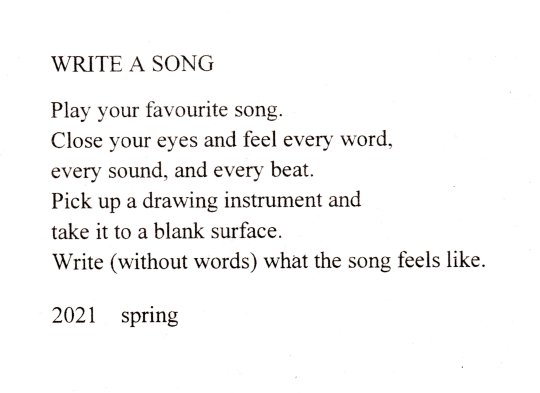
‘Write a song’ submission for ‘Resite’ - offset lithography on paper.
‘Resite’ is an assembling publication by Field Study that offers an element of audience participation. The editions are a nod to the Fluxus tradition of performance-based interactions and the pages are packed with scores, manifestos and documentation.
Since learning about the Fluxus movement from the Block Zero projects we got involved with I have been very aware of how my work is in dialogue with many Fluxus concepts. In lockdown I began to explore the links my practice has with performance and I have understood that these moments of outward reflections of inward feelings are candid happenings, much like those popularised by Fluxus artists in the 1960s.
I printed an edition of forty double-sided lithograph prints that have an event score on one side, instructing the reader how to write a song in the way that I would transcribe one through asemic writing. The text in this print is a direct homage to Yoko Ono’s ‘grapefruit’ manual of scores, even down to the date sign off at the end. The reverse side is a polaroid photograph that documents one of these happenings. These prints will be included in the next Resite assembling book and each contributing artist will be given a copy of the finished publication.
Exhibitions
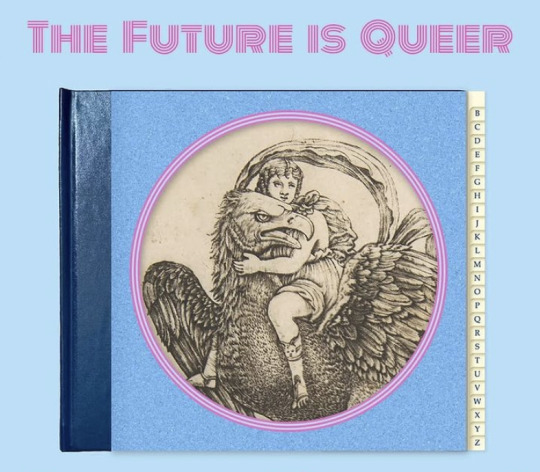
I was delighted to have work selected to show in a digital exhibition entitled ‘The Future is Queer’ - the first time that I have exhibited solely with other queer artists. I have only briefly touched upon this side of my identity in my practice, and so relished the chance to have myself placed under this umbrella for the purpose of this exhibition. I have a lot to say about queer culture, and I feel that now more than ever the world needs people to speak up about the treatment and mistreatment of people from the LGBT+ community. For this reason I see participation in this exhibition as a first step towards telling more honest stories about what it is to be a gay man in contemporary society.
In keeping with this idea I have also submitted works to be exhibited at Bristol Pride this summer. I noticed the advert on social media and am still awaiting a response. The exhibition would be widespread around the city centre as opposed to a singular exhibition. If I have understood it correctly, it sounds to be not too dissimilar from an art trail - where there are multiple venues around the city for people to wander around and discover.
‘Wild Things’ was a call out by Beach Gallery in Orkney, Scotland that I entered just for fun, which from time to time can be a breath of fresh air. The call asked for artworks that focussed on wildlife, and so I submitted a series of three bumblebee monoprints. I was thrilled to learn that my prints are the focal point on the gallery’s website, being the first works you see upon entering the virtual gallery.
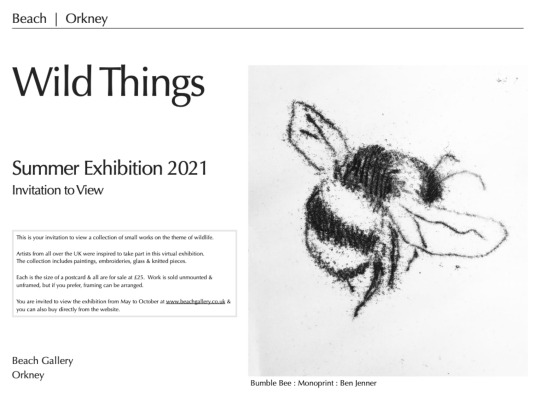
‘Bumble Bee III’ submission for ‘Wild Things’ exhibition in Orkney, Scotland - monoprint on paper.
Residency
A big achievement for me during lockdown was having my application accepted to be an artist in residence at the Museum of Loss and Renewal in Collemacchia, Italy.
I have been extremely fortunate to have been able to spend the last three years developing my practice and honing my interests in visual poetry in an encouraging environment, however I am ready to explore my practice away from an educational institution. There have been moments of anticipated self-doubt as the final weeks of the masters degree are looming. The opportunity to explore my practice in a residency setting would encourage personal growth in the form of self-confidence as well as being able to assert myself as an artist in a creative context.
Furthermore, since returning to my studies I have experienced first hand how important it is to discuss and unpick ideas with a peer group, and so I am keen to collaborate and build relationships with other artists at the residency.
I am eager to continue developing my ideas of discerning a narrative through reading asemic marks, and investigating where we might find narratives. I have proposed that during the residency I would like to place myself in the local community and examine through first hand research how these ideas might translate in a setting where the language spoken is not my mother tongue. How might a language that I don’t understand translate visually? My aim will be to record my findings through drawing and printmaking.
Immersing myself within a village community will provide extensive opportunity to explore a dialogue with new people and hopefully build a body of work that not only reflects these conversations but serves as a common language that is able to be read by all. I must remember to keep the emotional attachment at the heart of my practice and remind myself of the lessons I learnt from my residency at Bower Ashton Library - not to allow my work to become too formulaic and emotionally cold.
#practice#exhibition#publication#contemporary art#contemporary printmaking#asemic#asemic art#asemic writing#visual poetry#vispo#monoprint#bumblebee#printmaking#masters#mamdp
0 notes
Text
Xu Bing
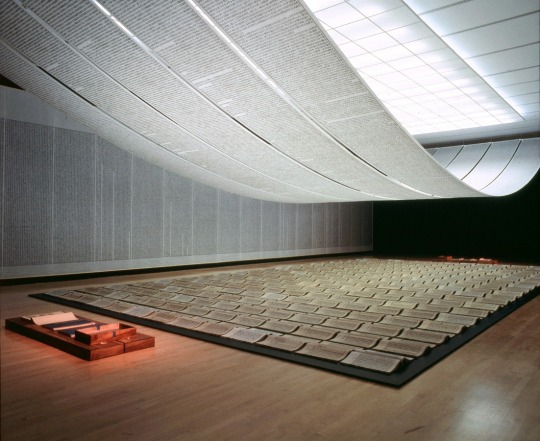
‘Book from the Sky’ by Xu Bing, 1987-1991- mixed media installation (installation view at Crossings/Traversées, National Gallery of Canada, Ottawa, 1998).
Xu Bing is a multi-disciplinary printmaker who is world renowned for his prints, calligraphy and installations that discuss the purpose of language. In a year where I have been questioning where my practice fits in relation to print it has been useful to explore Bing’s past works.
The body of work that he is most known for is ‘Book from the Sky’. This was a huge project wherein which Bing carved over 4000 woodblock characters that appear to be Chinese but were in actual fact completely void of semantic meaning. He explains that the conceptual reasoning behind the work was to provoke confusion and unease in his audience, given their attempts to read the illegible.
‘Book from the Sky’ is a great example of the combination of printmaking and asemic writing. Though it is not strictly handwritten, the character forms exude a handwritten feel due to the emphasis placed on the calligraphic mark. This is similar to the ‘lostalgia’ typeface that I made but lost faith in due to its inability to communicate gesture and emotion. The typeface became an experiment that exists ‘just because’. I think the most notable difference between 'lostalgia’ and 'Book from the Sky’ is that Bing made his characters intentionally to instil a discomfort in his audience whereas I came from a place of inquisitiveness.
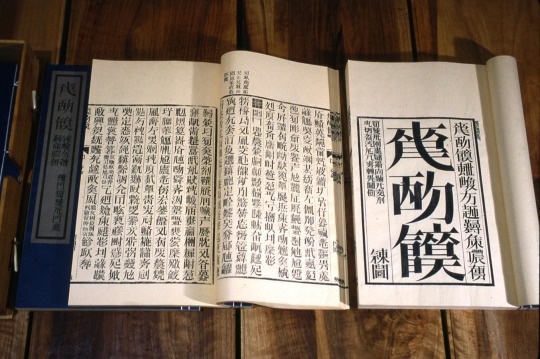
‘Book from the Sky’ by Xu Bing, 1987-1991- relief printed artist’s book.
I am motivated by the many ways in which Bing installed and presented these prints. A great many artists’ books laid in rows on the floor, scrolls hanging from the ceiling and suspended on the walls. It really looks to be an all encompassing experience, and one that confidently announces his cultural identity through the synergy of subject matter and presentation.
My peers and I will not be experiencing an end of degree exhibition this summer, but I have been thinking ahead for future exhibitions nonetheless. In particular I have been contemplating how I might curate my drawings and prints in a creative way that highlights my own identity. Seeing the many ways that Bing has displayed his work has shown that there are unique ways that asemic works and book arts can be exhibited away from the standard white wall gallery, eye-level hanging aesthetic to which we are accustomed.

‘Square Word Calligraphy’ by Xu Bing, ink on paper - 1994-present.

‘Square Word Calligraphy’ by Xu Bing, ink on paper - 1994-present.
‘Square Word Calligraphy’ is an ongoing body of work by Bing that shows the meeting of Eastern and Western calligraphy. He combines the two writing styles to create a new ‘species’ of language. Though the characters look a little uncertain, they feel different to the nonsensical forms found in ‘Book of the Sky’. The audience feel a sense of accomplishment and relief when they learn the characters are decipherable.
This revelation is welcomed further upon entering Bing’s installation that is an imitation of an adult literacy class. The exhibition space includes textbooks, videos and practice papers to evoke the sense of being in a classroom. In effect the viewer becomes a student being taught how to write this new language. I think this interactive method of exhibiting is not only novel in its execution, but also inspires an excitement about writing by hand. This is an area of focus that I am keen to address at the moment. I intend to include this participatory notion in my ‘Fantasy Exhibition’ written report as a means of testing ideas for the future. Setting up some sort of participatory performance area would have been something I would have liked to have explored if the degree show would have carried on as we would have hoped.

‘Book from the Ground’ by Xu Bing, mixed media - 2003-present.
The third and final example of Bing’s works that I have been reading about is ‘Book from the Sky’s companion volume, ‘Book from the Ground’. Bing noticed on his travels that despite where he was in the world he could understand the icons and symbols that directed him towards the shops or the toilets or where to eat. He began to collect these pictograms and curated this source material into a novel that tells the story of a day in the life of an office worker.
He wrote this book in such a way that anyone from anywhere in the world could read it, regardless of their cultural background, educational history or linguistic ability. Bing realised that contemporary culture is so saturated with informational logograms and pictograms that this universality meant the story would not need to be translated. As such, the book could be published anywhere in the world and still be understood. In contrast to ‘Book from the Sky’, this novel aims to one day bring to fruition Bing’s vision of a universal language. I have come across this notion before from my research around ‘Esperanto’.
The idea of a globally inclusive language seems to be one that asemic artists address quite often. This is such a big question to think about, and might be one to come back to in the future. I am looking ahead to the possibility of further research, and this inquiry is food for thought for a potential research proposal.

‘Book from the Ground Software’ by Xu Bing, computer software and mixed media installation - 2003-present.
In terms of exhibiting this work, Bing made a database software of symbols that users can access, entering words in English or Chinese that will be translated using his lexicon of signs. In essence this software becomes a go-between method of communication between the two languages. This forward thinking project will regularly become outdated due to the rapid rate that technology is advancing, and so Bing will keep his software as up to date as possible - like the dictionary in the real world.
These are three varying examples of how language has been explored to confuse, to inspire and to communicate. I am grateful to have happened across Bing’s work, I feel so excited that there are artists that are using linguistics in such a creative way. I am particularly encouraged by ‘Square Word Calligraphy’, solely for the fact it urges the spectator to be part of the performance and to advocate writing by hand. Much of the ideas I have garnered from this research have stimulated thoughts for later proposals, I have begun to think about discourse around ideas of asemic writing, narrative and universally understood languages and this has been a solid starting point from which I can branch out and build upon.
#influences#xu bing#calligraphy#book from the sky#book from the ground#chinese#chinese writing#linguistics#language#asemic writing#asemic#asemic art#visual poetry#vispo#artist#contemporary art#writing#handwriting#printmaking#masters#mamdp
3 notes
·
View notes
Text
Handwriting

‘Good Handwriting and How to Acquire It’ by John C. Tarr - 1952.
I find it strange to imagine a world where handwriting does not exist. Inevitably the emphasis on writing by hand has become less so. Technology is advancing at a rapid rate and children have access to technologies that those from my generation and before would not have done. I have read a number of articles that suggest handwriting is in decline, in favour of touch typing, and the even more relevant to today, ‘thumb typing’ (typing on your smartphone).
Though touch typing is not as contemporary a concept as thumb typing, when you break down the thought process behind it it is a little unnerving. The idea of manifesting a neural relationship with your computer by understanding which keys are where so that typing at the speed of thought is commonplace - becoming one with the computer. I think that the problematic reasoning behind it is routed in capitalism and the idea that we must maximise our time by being as productive as possible at every waking hour. Typing at the speed of thought is far more cost effective than the more leisurely route of writing by hand and letting the ideas stream, and then edit later on.
What I think people are beginning to realise is that there must be a way of establishing better work-life balance. It is not healthy to adopt the attitude that success is achieved by always being productive and accomplishing goals. I found during lockdowns that if I had days where all I could achieve was to get out of bed and get washed and dressed then that was a success.
The book ‘Good Handwriting and How to Acquire It’ discusses the idea of the perfect handwriting. It has chapters about how the ideal cursive script is achieved and what habits to avoid and unlearn with regards to penmanship. At the time of its publication it was likely a valuable tool for grasping a desired handwriting style. Today I find it to be rather antiquated in its execution, but a charming time capsule of a period where these matters were of the utmost importance. Because handwriting as a whole is now underused and underrepresented I would argue that all handwriting is good handwriting. It offers a sense of individuality that digital communication does not.
There are instances of schools opting to not teach cursive handwriting as part of their curriculum. In 2016 Finland began phasing out cursive script as part of their schooling, with Switzerland aiming to only teach a basic script (Hanke, 2016).
The language being implemented in such articles is very telling about attitudes towards handwriting. In an article regarding the syllabus in America it is described as ‘a big old waste of time... also, because computers’ (Boone, 2013). In an article about the abolishing of handwriting in Finland the first sentence says ‘it seems incredible that in the 21st century schools are still teaching children to scratch marks on paper’ (Swift, 2014). The diction in such articles reinforce ideas of handwriting being an archaic and primitive pastime, and not the individual sense of self and character that I would proclaim it to be. In Boone’s case, again we are reminded of writing by hand not being an appropriate use of our time.
In ‘Does Handwriting Have a Future’ Vilem Flusser discusses in great length the theory of handwriting, and how technology threatens its very existence. In the introduction he states:
‘Information is now more effectively transmitted by codes other than those of written signs. What was once written can now be conveyed more effectively on tapes, records, films, videotapes, videodisks, or computer disks, and a great deal that could not be written until now can be noted down in these new codes’ (Flusser, page)
Though this book was written in 1987 there are aspects that we can extract that are relevant to today. Flusser is correct that there are various means of disseminating information, some more effective than others but not all are as expressive as the written word. I suppose because society is so intent on being productive and instantaneous, it is quicker to digest an image than it is words. As a result the world has become a more visual landscape, encouraged by social media.
At the end of last year I touched upon society’s reliance upon technology and computers, and once again I wonder what might happen if all of a sudden the computers just stopped. Or to a lesser extent, for example if your computer ran out of charge but you needed to note something down. Surely there must be some degree of knowledge of the handwritten word, unless perhaps one day the idea of handwriting will be that far removed from our day to day lives that there might be handwriting masters and experts, as it would be regarded a specialist skill.
I am curious to know that if handwriting were to cease to exist, would our ability to read handwriting go with it? If you are unable to write in cursive, would you still be able to read and recognise pre-existing cursive scripts? There is a lot of history that we would not have access to if this would be the case, a saddening prospect all for the sake of growing capitalism.
1 note
·
View note
Text
Exhale

‘Exhale II’ - monoprint on paper.
‘Exhale’ is a series of drawings and monoprints that are an example of how I have developed my practice to help me cope with my mental wellbeing throughout the pandemic. I began to develop the ‘x’ motif from the work I made for ‘The World is a Handkerchief’, and since then I have continued to explore the visual properties of the letter ‘x’.
In this instance I developed it into a breathing and drawing performance that became a critical aspect of my day to day life in lockdown. I suffered from moments of crippling anxiety, my mind would wander, not return and not listen to reason. Upon reading about possible ways of living with anxiety I found that a lot of remedies for situations such as these included meditational practices.
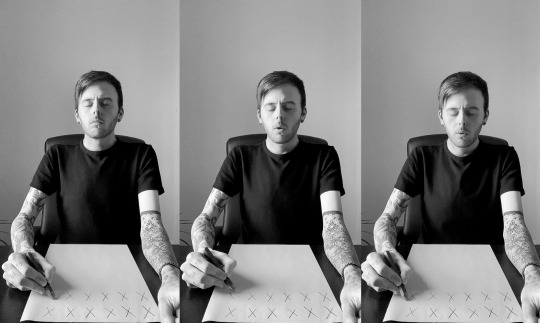
Screenshots from videos of daily ‘Exhale’ performance writings.
This series of artworks were born through these moments of calm exploration. I combined my desperate need to address my lockdown anxiety with my creative practice, and would inhale deeply, and then draw an ‘x’ with every exhale. I made many monoprinted drawings through these daily performances, and the routine of creating them began to replace the terrifying anxious thoughts that plagued my mind.
This was also my first journey into documenting the performative aspect of my practice. Throughout the MA I have discussed how I enjoy the performance of printmaking, from using my body as a matrix to the repetition of the movement of the body during printmaking processes. I recently expressed my concerns that I was trying to force my work into a printmaking box where it might not be necessary to do so. I felt much more comfortable and honest in making this series and recording the performance. I would like to continue to explore documenting the performance of some gestural works, assessing the change in tone in the performance as well as the outcomes created.
youtube
‘Exhale’ - performance writing.
#practice#processes#performance#performance art#exhale#monoprint#drawing#contemporary art#video art#asemic#asemic writing#asemic art#anxiety#meditation#mental health#wellbeing#printmaking#masters#mamdp
1 note
·
View note
Text
James IV and Inchkeith

‘James IV, 1473 - 1513. Reigned 1488 - 1513′ by Unknown, after 1578 - Oil on panel.
Throughout history there have been a number of language deprivation experiments recorded, wherein which children are isolated from society and language in order for the conductor of the experiment to ascertain the origin of language itself. What language or method of communication might someone grow up to voice if they grew up completely detached from the world?
The story that fascinates me the most is that of James IV of Scotland, who allegedly performed such an experiment on the island of Inchkeith. The rumours speak of James IV casting out a mute woman and two children to grow up segregated from mankind to discover what language they might grow up to speak. He believed that this speech would be the purest form of communication and would be the intrinsic ‘language of God’.
Unfortunately there are no sources that can verify this story, many modern historians claiming it implausible. However, there are also no sources to say that it could not have happened. It has been reported that among the King’s intellectual interests, his love of language and communication was the most significant; he himself was fluent in Scots Gaelic, English, Latin, French, German, Italian Flemish and Spanish. I believe it not in the realms of impossibility that someone with such an interest in language and with that much influence could not have put this inquisitiveness into action and perform such an inquiry.
I have enjoyed reading stories about language deprivation, though it seems cruel to intentionally deny someone the option to communicate in the way we have been privileged to. The fundamentals of communication have progressed considerably since the dawn of man and to strip someone of that is unfair. The notion of a pure verbal articulation is interesting though, the idea that not having any persuasion or corruption from the outside world might culminate in a refined language. I wonder how that might translate in written form.
In all honesty, I don’t think these peculiar experiments would amount to much in terms of a divine language being discovered. I expect that the reality of it might be reminiscent of the forms of communication by the populaces of the Palaeolithic era; evocative cave paintings and limited verbal expression. That being said it makes for an interesting read, and also encourages us to appreciate the advancement of communication, both verbal and written. The very fact that written communication and the printed mark exist allows the ability to communicate not only with each other in the present but to record information for future generations; communicative time travel.
#influences#james iv#james iv of scotland#inchkeith#language#linguistics#communication#cave drawing#writing#printmaking#masters#mamdp
5 notes
·
View notes
Text
Dead Letters

‘Dead Letters’, varied edition of 50 - relief print on watercolour postcard.
I have been reflecting on the minimal amount of physical work that I have made this academic year and this is in part due to the lack of access to university facilities. Disheartening as this may be, it has been a necessary restriction due to the current global crisis. With creative motivation being difficult to muster at the moment I thought it might be productive to rethink past works. The project that I spent the most time on was the ‘lostalgia’ typeface that I made in isolation. I spent a lot of time on this project, most of which was incredibly intense as I was unable to leave my bedroom. It might be cause for regret to not have experimented further with their limitations, however they may unfold.
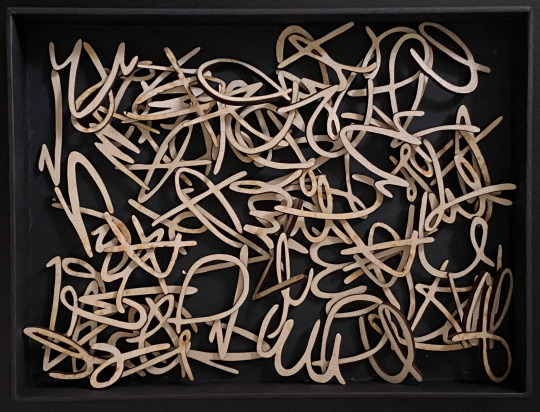
‘lostalgia’ typeface - lasercut plywood in portfolio presentation box.
Another series of ongoing works that I have undertaken since the start of the pandemic is that of postal art. The resurgence and emphasis that has been placed on correspondence in the last twelve months has been more than apparent. I have taken part in many projects that utilise this idea and it has always initiated a sense of hope and optimism waiting for the post to arrive. After submitting to various Fluxes-inspired mail art projects around the world I would like to take it upon myself to conduct my own mail art intention. I feel that the typeface I made in conjunction with the postal service might breathe new life into the two currently stagnant projects.

Submission for ‘Postcards for Perec’ mail art project and exhibition.
I was thinking about the individual characters from my typeface and how the letters are simply sterile. The lack of gesture and emotive content render them empty and static in comparison to some of my more gestural drawings and prints. Therefore I would like to impose meaning upon them.
I recall an album I used to listen to when I was in my teens by the Finnish rock band, ‘The Rasmus’ called, ‘Dead Letters’ that offered a definition to the title in the album booklet. It states:
‘A dead letter is a letter that has never been delivered because the person to whom it was written cannot be found, and it also cannot be returned to the person who wrote it.’
I propose a dual meaning to this definition, and offer that a dead letter not only references a letter in the postal sense, but also in the written sense; a written letter that has no meaning is also a dead letter. At this point I must state that I am referring to overall emotive meaning, and not semantic content. Asemic writing still ‘means’, it just offers no semantic meaning.
The project that I set in motion incorporates both definitions and transpire as a series of postcards that feature a series of the dead letters on them, to be posted (and hopefully not to become a dead letter in the postal sense). The selection of letters are printed intuitively in a variety of combinations.

‘Dead Letters’ album by The Rasmus, 2003.
I have also taken inspiration from a printmaker whose work I have followed for many years, Camilla Taylor.
Taylor conducted an artist’s talk through Saddleback Gallery that I was fortunate enough to listen to online. In her discussion she explains how she has an almost spiritual dedication to the materials she brings in to her studio. This obligation ensures that the materials are used in one form or another. For example; discarded prints will be upcycled into new artworks and zinc etching plates will be melted down in order to make sculptures from them. This notion furthered my desire to really get the most from the letterforms that I had made, seeing it wasteful of not only the material, but also the time and thought that went into their production.
In response to the pandemic and feelings of social isolation Taylor made a series of new works with the idea to post them to her audience. She made a series of symbols prompted by events of the year and each print depicted a different variation of the stories, thus creating a conversation between artist and viewer.
I enjoy the way Taylor has utilised the mail art concept as a means of bringing the gallery situation in to the viewer’s home. It has become increasingly difficult to sustain excitement at the prospect of yet another digital ‘exhibition’ and so this seems to be a resourceful way to safely bring art in the physical sense into your audience’s domestic setting. At the end of the second year I produced a digital showcase of my Professional Practice module; a diagrammatic view of the exhibition space I would have liked to have shown in. I feel that the method of sharing work that Taylor has implemented is much more authentic and it has encouraged me to think along this train of thought in preparation for the lack of an end of degree show in June.

‘A Conversation’ by Camilla Taylor, 2021 - relief print on paper.
#practice#influences#mailart#fluxus#postcard#camilla taylor#asemic#asemic art#asemic writing#visual poetry#vispo#relief print#relief printing#printmaking#masters#mamdp
7 notes
·
View notes
Text
The Codex of Rohonc

Pages from the Codex of Rohonc.
The Codex of Rohonc is an illustrated book by an unknown author whose mystery rivals that of the Voynich Manuscript. It is named after the city of Rohonc in Hungary, where the book resided until 1838, after which it was donated to the Hungarian Academy of Sciences. The text is written in an as yet undeciphered language and writing system but is continually being investigated by scholars and aspiring cryptologists alike. The paper upon which the Codex was written has been carbon dated to the mid 1500s, though it is currently not known when the book itself was written.
In contrast to the illustrations found in the Voynich Manuscript that leave much scope for discussion, those evidenced in the Codex of Rohonc appear to have seemingly biblical leanings. Most of the imagery can be understood to be scenes as distinct as the Three Wise Men in Bethlehem or Jesus being crucified. These Christian figures would suggest the mysterious book has a religious purpose, but if that is the case then why is the text written in such a way that no one could understand it? Perhaps it was written by someone renouncing religion, and so the text is coded to hide this fact from the Church, or maybe the religious illustrations are to distract from the writing and the true nature of the book. I feel that because the illustrations would point to the book being theological in some form or another, I would propose that it is less likely to be a hoax. Of course, this is speculation, and part of the book’s allure.
It is interesting to note that the number of individual written glyphs in the Codex is ten times higher than any known alphabet - currently the list sits at 792 characters. However some symbols are scarcely used, which perhaps leads us to believe that the glyphs are encoded syllables or words, in which case they would be logograms and not letters.
If the written codex is indeed a hoax, the very fact that it is compiled in to a bound book enforces the notion that there is a story to tell. The story might be a work of fiction, a recipe book or instruction manual, but nevertheless it is the format of the writing that alludes to the promise of decipherment. I have questioned this idea before with regards to the Voynich Manuscript and the Voynich Symphony. How much of our yearning to decipher the writing comes from the fact that it is a book? I wonder how much we strive to read and understand asemic works with the hopes of grasping semantic content for the sheer fact that we understand the book format to be a method of disseminating information.
Regardless of what the true purpose of the Codex of Rohonc may be, it provides a point of discussion around the nature of the written word and its capacity to engross, fascinate and capture our attention. There are many conceivable hypotheses and educated guesses that can be reached, but it is my hope that there will always be a Codex of Rohonc or Voynich Manuscript to keep the passion for handwriting theory alive. I intend to continue researching ideas of constructed languages, universally understood languages, and also exploring the limits of the format and presentation of the written word; as this seems to be quite an integral part of how we approach our reading of both semantic and asemic words.

Pages from the Codex of Rohonc.
#influences#codex of rohonc#Rohonc Codex#voynich#voynich manuscript#conlang#constructed language#asemic#asemic art#asemic writing#book#bookart#bookarts#printmaking#masters#mamdp
43 notes
·
View notes
Text
Hassan Massoudy
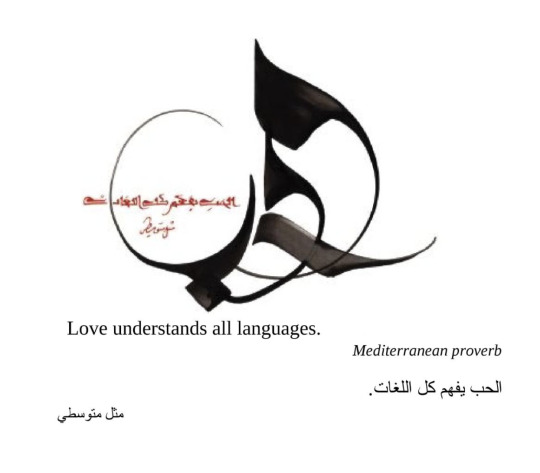
‘Love understands all languages.’ by Hassan Massoudy, 2017 - ink on paper.
As a consequence of reading ‘Habibi’ my research found me at the doorstep of artists that integrate middle eastern calligraphy into their practice. One such artist is the Iraqi painter, Hassan Massoudy.
The images of Massoudy’s performative approach to his practice have motivated me to explore scale in a similar way. I have previously touched on scale in terms of a larger surface area, but continued to use the same drawing implements. What might happen if the size of the tools for drawing were also considered? I have always been fascinated by the performance of handwriting itself, and how the execution of writing is as important as the product. Whilst in a university setting I feel it would be beneficial to investigate this interest as it has great potential for further speculation.

Hassan Massoudy performing asemic calligraphies in his studio.
I have been engrossed in Massoudy’s book entitled, ‘Calligraphies of Love’ that offers quotations and poems around a general theme of love and shows how he has reproduced these sentiments in an asemic calligraphic manner. He explains that in doing this he enables a grasp of the inner meaning of the words. In a sense this is how I have approached certain areas of my practice, in particular the asemic translations of my own poetry collection, ‘anagapesis.’ I would describe it as an attempt to to depict the overarching emotive content of the source material as opposed to a direct and literal translation.
Massoudy has become an important figure in the contemporary calligraphy community, chiefly amongst a new generation of calligraffiti artists. ‘Calligraffiti’ is defined as being an amalgamation of calligraphy and graffiti, creating a new form of street art that blends tradition and contemporaneity. The calligraffiti artist takes inspiration from words, not allowing themselves to be confined by language itself and making these calligraphic evocations into something elusive, fresh, and displayed in a public setting.
It is exciting to read on how widespread the visual poetry community can be found, and subsequently the impact it can have on other creative disciplines. I briefly mentioned after attending the ‘Seen as Read’ course about taking my work into a public setting, and it is encouraging to find that there is a community of asemic artists already doing this. So far the extent of my public art has stretched to QR code stickers, which in all honesty is as far as I am comfortable with at the moment. This year is about exploring ways in which I can share my work with my audience and I must continue to do so in a way that I am confident in pursuing.

‘When you glanced at me, I learned the meaning of love.’ by Hassan Massoudy, 2017 - ink on paper.
#influences#hassan massoudy#calligraphy#calligraffiti#asemic#asemic art#asemic writing#performance art#visual poetry#vispo#poetry#printmaking#masters#mamdp
37 notes
·
View notes
Text
‘Habibi’ - Craig Thompson

‘Habibi’ front cover by Craig Thompson.
I was recommended this book by a work colleague some time ago and bought it relatively quickly afterwards, but found the 672 page tome intimidating and I did let it collect dust for a while. Now that we find ourselves in lockdown again and creative motivation is becoming increasingly difficult to muster, I have decided that rather than merely float from day to day I will put my efforts in to research in the hopes that inspiration will strike.
I am pleased that I left this book for when I needed some artistic encouragement, it is the most exquisite book that I have read in years. ‘Habibi’ is a graphic novel about two former child slaves, and set in a fictional Islamic landscape. The children become separated and go on their own unique journeys into adulthood before reuniting and struggling to find where the other now fits into their life now that they are essentially familiar strangers.
Thompson began writing ‘Habibi’ in response to the negative attention given towards the Middle East following the 9/11 attacks. He explains how the graphic novel was an attempt to better understand Islam and focus on the beauty of Arabic and Islamic cultures. In the creation of this contemporary parable, Thompson was influenced by calligraphy from the Middle East, adding that his interest in making a mark on paper and letting that be cursive shorthand for an idea is the origin of cartooning.

Excerpt from ‘Habibi’ by Craig Thompson.
The calligraphy itself is stunning and has allowed me to see how the handwritten mark can be used to connect a story throughout a publication, and not just for isolated, single page narratives. The ebb and flow of the text and image coupled with the calligraphic elements allowed for a leisurely read of such a gripping story.
Though not necessarily asemic writing, the otherness ‘walls’ are torn down when the gestures of the marks are explained as part of the story. We are taught how the different strokes of the pen create words, and given a lesson of sorts as to how the language is constructed. The performative gestures are an important aspect of the narrative and in the concluding pages we learn about how these relate to the characters, their own personal journey and indeed the title of the book.

Excerpt from ‘Habibi’ by Craig Thompson.

Excerpt from ‘Habibi’ by Craig Thompson.

#influences#habibi#craig thompson#graphic novel#calligraphy#handwriting#asemic#asemic art#asemic writing#comic#printmaking#masters#mamdp
26 notes
·
View notes